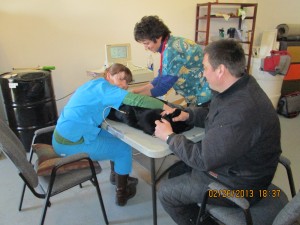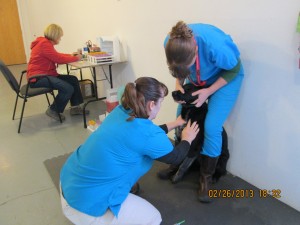Pre-race Mandatory—Team veterinary check with EKG, Blood Work, Physical Exam
If you are a musher, one of the big items on your checklist is getting your dog team properly examined before today, Wednesday the 27th of February. That includes proof that you have vaccinated and wormed the dogs, each dog has a readable microchip, a vet has examined the team, blood work completed and approved for each dog, and each dog has completed an EKG test. All this is outlined, for those that are really interested in the details, at Rules 37 to 46 of the Iditarod Rules. You can check it out at the Iditarod website.
This responsibility seems complicated, but it actually sorts itself out logically. To check out the final steps of the exam, I hitched a ride with John Baker, the 2011 Iditarod Champ, to Wasilla. Here, the Iditarod had set up one of several exam areas populated with Iditarod volunteers with the necessary veterinary certifications to collect blood samples and conduct EKGs.
While John was bringing the dogs into the facility, I took a few photos of the crew. In the first photo you can see Nicole from California standing with a dog, and Kara, from Tennessee kneeling and preparing to take a blood sample. In the background, Kay of southern California is at a laptop documenting blood samples, the microchip number for each dog, and the EKG records.
Naturally, I have a lot of questions because these women have examined 100’s of sled dogs. “Are you getting good at drawing blood?” The crew affirms that Kara is the world’s expert, she smiles, and agrees and that she knows what she is doing. The blood samples are labeled and filed. Later, profiles for each dog will be reviewed as a general health indicator, and some will be retained for drug testing (check out all the prohibited drugs in the rules.)
“Ok, so you have seen hundreds of dogs over the last couple of years, what are you seeing?” This year and last year the crew noticed the dogs were bigger, more muscular. John’s dogs were very dense, many of them sixty five pounds and more. A few, John added, might even weigh close to eighty pounds. The reason? Hard training and an increased effort to feed high quality rations to increase muscle mass.
What about personality from team to team? “We really notice which teams have been handled. Sled dogs are easy to handle anyway, but some of them just relax when we are doing work with them. The most anxiety is when we turn them over on their sides to attach probes for the EKG. The males, in particular, are the most concerned because their belly is exposed and they are in a very vulnerable position. They must trust us to relax.”

note Cassandra attaching probes, Nicole keeping husky relaxed and laying on side, and John seated and holding head
Look at the photo 2 and note Cassandra, attaching clips to points on the legs and chest, Nicole holding the dog supine, and John, seated, holding the head. The EKG machine in the background records heart rate data which will later be reviewed by a cardiologist for abnormalities.
While all are busy working, I pepper them with questions. Can you see differences in teams, should I call Jimmy the Greek and start placing bets on which teams have the best EKG, can you predict a top ten team, and so on? The girls are good natured and try to be reasonable.
“We definitely notice that some teams have different coats, which makes it harder in some cases, to part the hair, and attach the EKG machine clips to the skin.” John’s team, just for an example, is trained above the arctic circle at Kotzebue, and it was noticed that his dogs have very dense, thick, coats.
Cassandra has been volunteering for a number of years and her observations were particularly revealing. She notices that the dogs which are able to relax on the table are also the same dogs which have the capacity to rest on the trail. Since she also volunteers and goes out on the trail during the race, she sees the same dogs in checkpoints and can verify her own observations.
These women work in veterinary clinics and they observed that a normal house dog, especially a big one like a sled dog, would be very hard to handle in these circumstances. In particular, their resting heart rates would be elevated while everyone struggled to keep the dog laying down on the table. John’s dogs, on the other hand, fairly easily resigned themselves to laying on their side and waiting out the exam. You can see in the photo that John and Nichole are pretty relaxed.
A relaxed and confident sled dog, resting on the exam table, will often have a resting heart rate of about 50. “In a few cases, I have noticed heart rates as low as 40.” These dogs, Cassandra told me, are the ones that come into a checkpoint and immediately relax, make a bed, and get some rest.
On the other hand, one of John’s dogs was a 2 ½ year old female running her first race. She cooperated with the exam, but the crew noticed immediately that she was concerned. That was reflected in her resting heart rate of about 105.
“If we tried this on normal house dogs, it would be very difficult to even get a normal reading.” The process of handling the dogs every day, harnessing for training, taking boots on and off, and loading and reloading in the truck is a daily ritual. The sled dogs are accustomed to constant handling.
As the dogs were taken out of the clinic and back to the clinic, John’s veterinarian examined each dog, thereby completing the examination requirements.
Necessary paperwork, including vaccination and worming records, is submitted to Dr. Stu Nelson, Iditarod Chief Veterinarian.


































